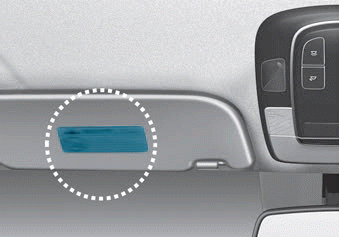Hyundai Palisade: Engine Control System / Engine Coolant Temperature Sensor (ECTS)
Hyundai Palisade (LX2) 2020-2025 Service Manual / Engine Control/Fuel System / Engine Control System / Engine Coolant Temperature Sensor (ECTS)
Description and operation
| Description |
Located in the engine coolant passage of the cylinder head, Engine Coolant Temperature
Sensor (ECTS) detects the engine coolant temperature. The ECTS uses a thermistor
with resistance in proportion to the temperature.
The electrical resistance of the ECTS decreases as the temperature increases,
and increases as the temperature decreases. The reference +5V is supplied to
the ECTS via a resistor in the ECM. That is, the resistor in the ECM and the
thermistor in the ECTS are connected in series. When the resistance value of
the thermistor in the ECTS changes according to the engine coolant temperature,
the output voltage also changes.ion duration and controls the ignition timing
using the information of engine coolant temperature to avoid engine stalling
and improve drivability.
During cold engine operation, the ECM increases the frequency of fuel injection
and controls the ignition timing using the information of engine coolant temperature
to avoid engine stalling and improve drivability.

Specifications
| Specification |
|
Temperature |
Resistance (kΩ) |
|
|
°C |
°F |
|
|
-40 |
-40 |
48.14 |
|
-20 |
-4 |
14.13 - 16.83 |
|
0 |
32 |
5.79 |
|
20 |
68 |
2.31 - 2.59 |
|
40 |
104 |
1.15 |
|
60 |
140 |
0.59 |
|
80 |
176 |
0.32 |
Schematic diagrams
| Circuit Diagram |

Harness Connector

Repair procedures
| Inspection |
| 1. |
Switch "OFF" the ignition.
|
| 2. |
Disconnect the ECTS connector.
|
| 3. |
Remove the ECTS.
(Refer to "Removal")
|
| 4. |
After immersing the thermistor of the sensor into engine coolant, measure
resistance between the ECTS terminals 3 and 4.
|
| 5. |
Check that the resistance is within the specification.
|
||||||||||||||||||||||||||
| Removal |
| 1. |
Switch "OFF" the ignition and disconnect the negative (-) battery terminal.
|
| 2. |
Remove the air cleaner assembly.
(Refer to Engine Mechanical System - "Air Cleaner")
|
| 3. |
Disconnect the engine coolant temperature sensor connector (A).
|
| 4. |
Remove the water temperature sensor (B) from the water temperature control
assembly.
|
| Installation |
|
| 1. |
Install in the reverse order of removal.
|
| 2. |
Replenish the engine coolant.
(Refer to Engine Mechanical System - "Coolant System")
|
 Manifold Absolute Pressure Sensor (MAPS)
Manifold Absolute Pressure Sensor (MAPS)
Description and operation
Description
Manifold Absolute Pressure Sensor (MAPS) is a speed-density type sensor installed
on the surge tank...
 Crankshaft Position Sensor (CKPS)
Crankshaft Position Sensor (CKPS)
Description and operation
Description
Crankshaft Position Sensor (CKPS) detects the crankshaft position and is one
of the most important sensors of the engine control system...
Other information:
Hyundai Palisade (LX2) 2020-2025 Service Manual: Front Seat Shield Inner Cover
Components and components location Component Location 1. Front seat shield inner cover Repair procedures Replacement • When removing with a flat-tip screwdriver or remover, wrap protective tape around the tools to prevent damage to components...
Hyundai Palisade (LX2) 2020-2025 Owner's Manual: Panic button, Start-up, Mechanical key
Panic button Press and hold the Panic button (5) for more than one second. The horn sounds and hazard warning lights blink for about 30 seconds. To cancel the panic mode, press any button on the Smart Key Start-up You can start the vehicle without inserting the key...
Categories
- Manuals Home
- 1st Generation Palisade Owners Manual
- 1st Generation Palisade Service Manual
- Changing Tires
- Check Tire Pressure
- AC Inverter
- New on site
- Most important about car
Air Bag Warning Labels

Air bag warning labels, required by the U.S. National Highway Traffic Safety Administration (NHTSA), are attached to alert the driver and passengers of potential risks of the air bag system. Be sure to read all of the information about the air bags that are installed on your vehicle in this Owners Manual.
Copyright © 2025 www.hpalisadelx.com



